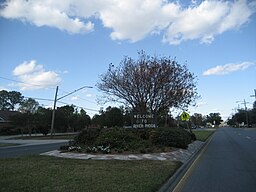River Ridge, Louisiana
| River Ridge | |
| Census-designated place | |
|
Welcome to River Ridge sign on Jefferson Highway
|
|
| Country | United States |
|---|---|
| State | Louisiana |
| Parish | Jefferson |
| Coordinates | 29°57′43″N 90°13′04″W / 29.96194°N 90.21778°WCoordinates: 29°57′43″N 90°13′04″W / 29.96194°N 90.21778°W |
| Area | 3.6 sq mi (9.3 km2) |
| - land | 2.8 sq mi (7 km2) |
| - water | 0.8 sq mi (2 km2), 22.22% |
| Population | 13,494 (2010) |
| Density | 4,827.9/sq mi (1,864.1/km2) |
| Timezone | CST (UTC-6) |
| - summer (DST) | CDT (UTC-5) |
| Area code | 504 |
|
Location of Louisiana in the United States
|
|
River Ridge is a census-designated place (CDP) in Jefferson Parish, Louisiana, United States, and a suburb of New Orleans. The population was 13,494 at the 2010 census.
The land that is now River Ridge was developed by French colonists and their descendants in the late 18th and early 19th centuries for large sugar plantations; these lined the Mississippi River in traditional French long-lot fashion. The plantations had relatively narrow waterfronts, in order to provide water access, and extended deeply back from the river. These plantations were developed by French colonists and their descendants; they depended on the labor of African slaves. Major landowners included members of the Trudeau and Sauve families. (Pierre Sauve (1805-1867) had a major plantation here known as Providence.)
The alignment of the major streets in the area are vestiges of this era. Sauve Road continues to be a main thoroughfare in River Ridge.
In 1849 a major flooding event known as Sauve's Crevasse occurred. The crude river levee at the Sauve Providence plantation failed under pressure of high water on the Mississippi. The massive flood inundated much of the land to the east, including parts of New Orleans. This crevasse occurred where a former meander of the Mississippi River once branched to form the Metairie and Gentilly Ridges.
In the early 20th century, an interurban transit line was constructed through this area. It served to connect the cities of New Orleans and Kenner. It was aligned along the present course of Jefferson Highway, which was improved from earlier roads.
For many years the area remained rural farmland, until the post-World War II suburbanization era. Aided by funding under the GI Bill, when enabled veterans to buy houses, large-scale suburban development began in the early 1950s. By 1965 virtually all of the area along the Mississippi River between Harahan and Kenner was developed. This area at the time was known as Little Farms, a name which well described its pre-urban history; this was also the place name officially recognized by the Post Office. (To this day Little Farms Avenue remains a major River Ridge thoroughfare.) Other subdivision names such as "East Bank" and "Rural Acres" were used as place names for the area at the time.
...
Wikipedia



